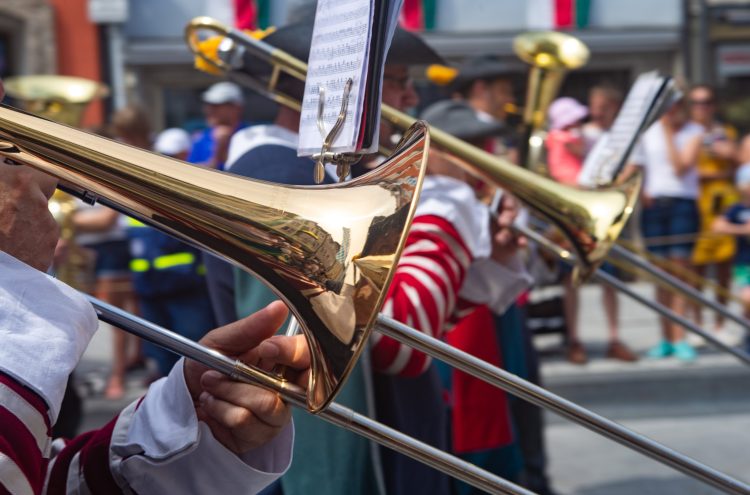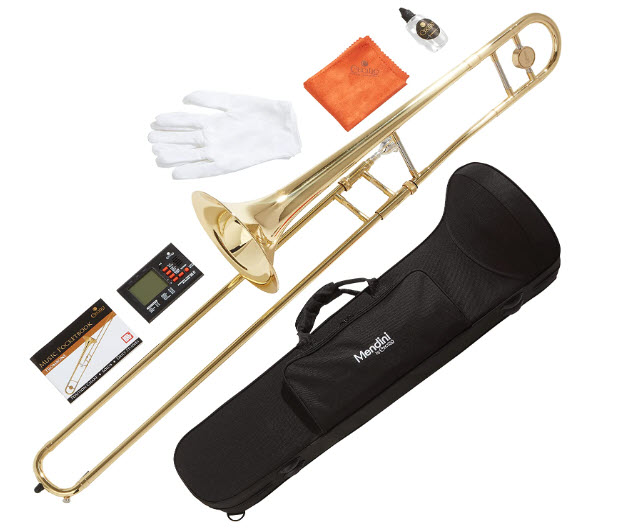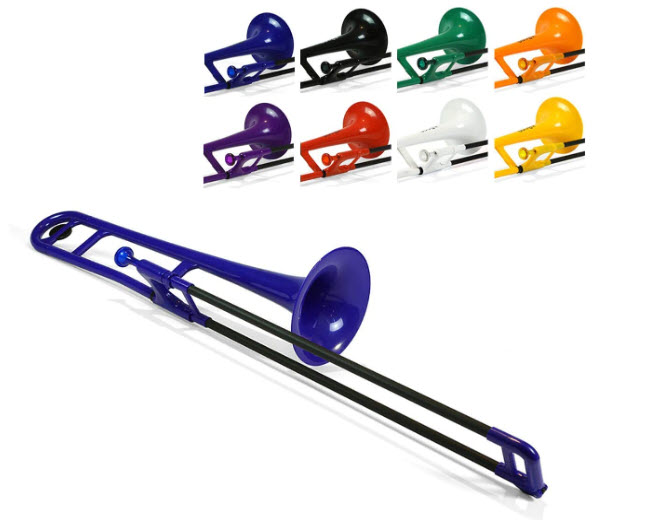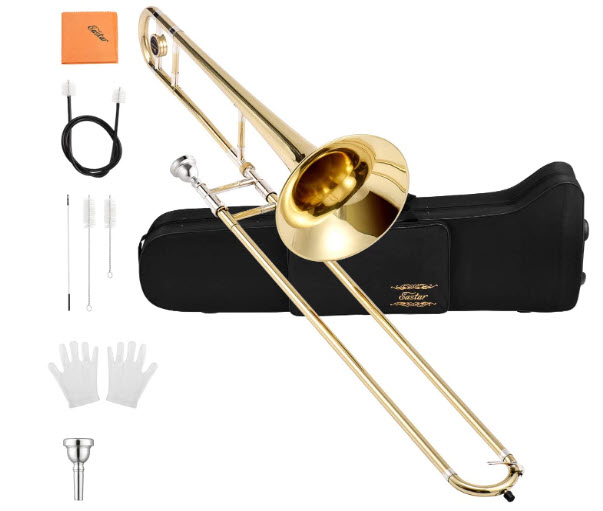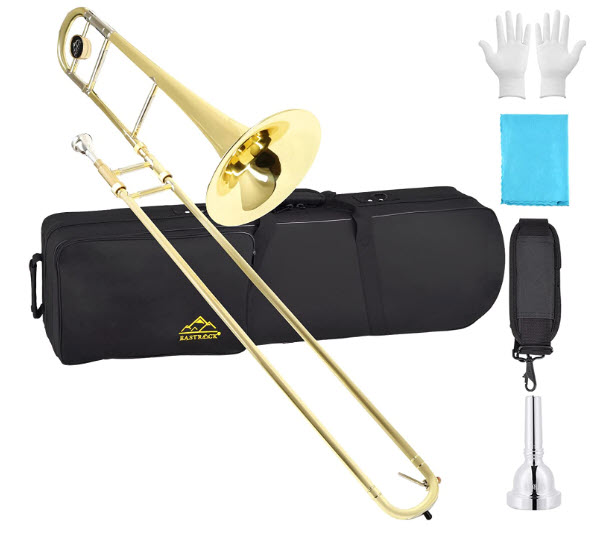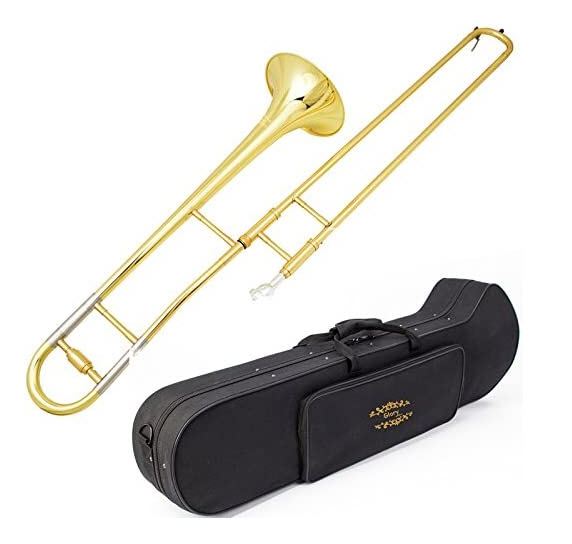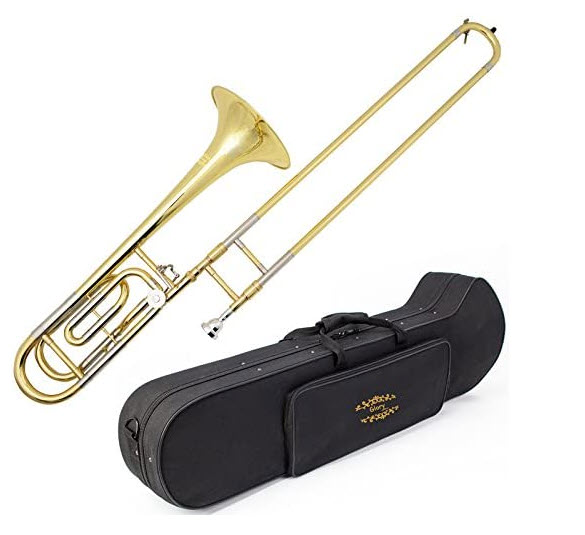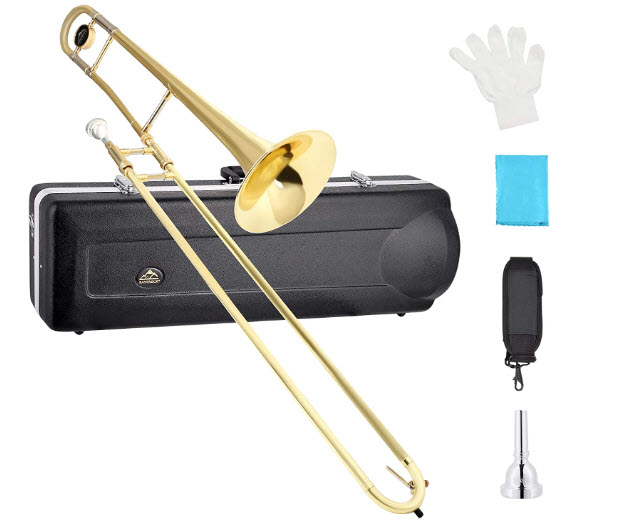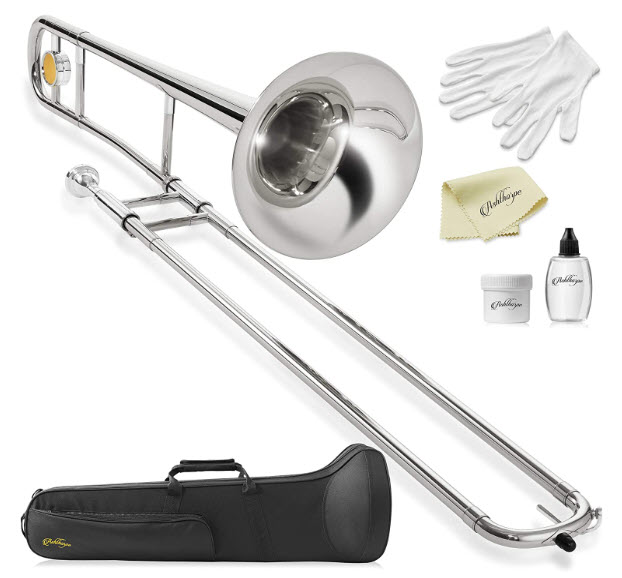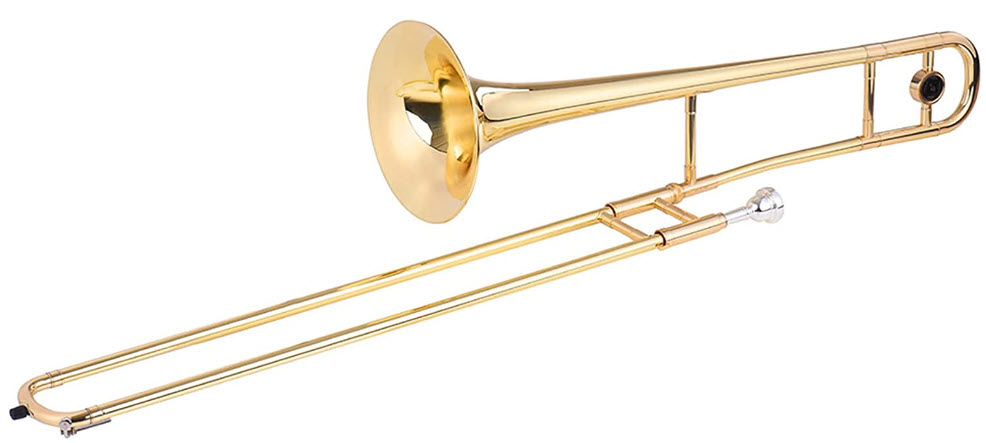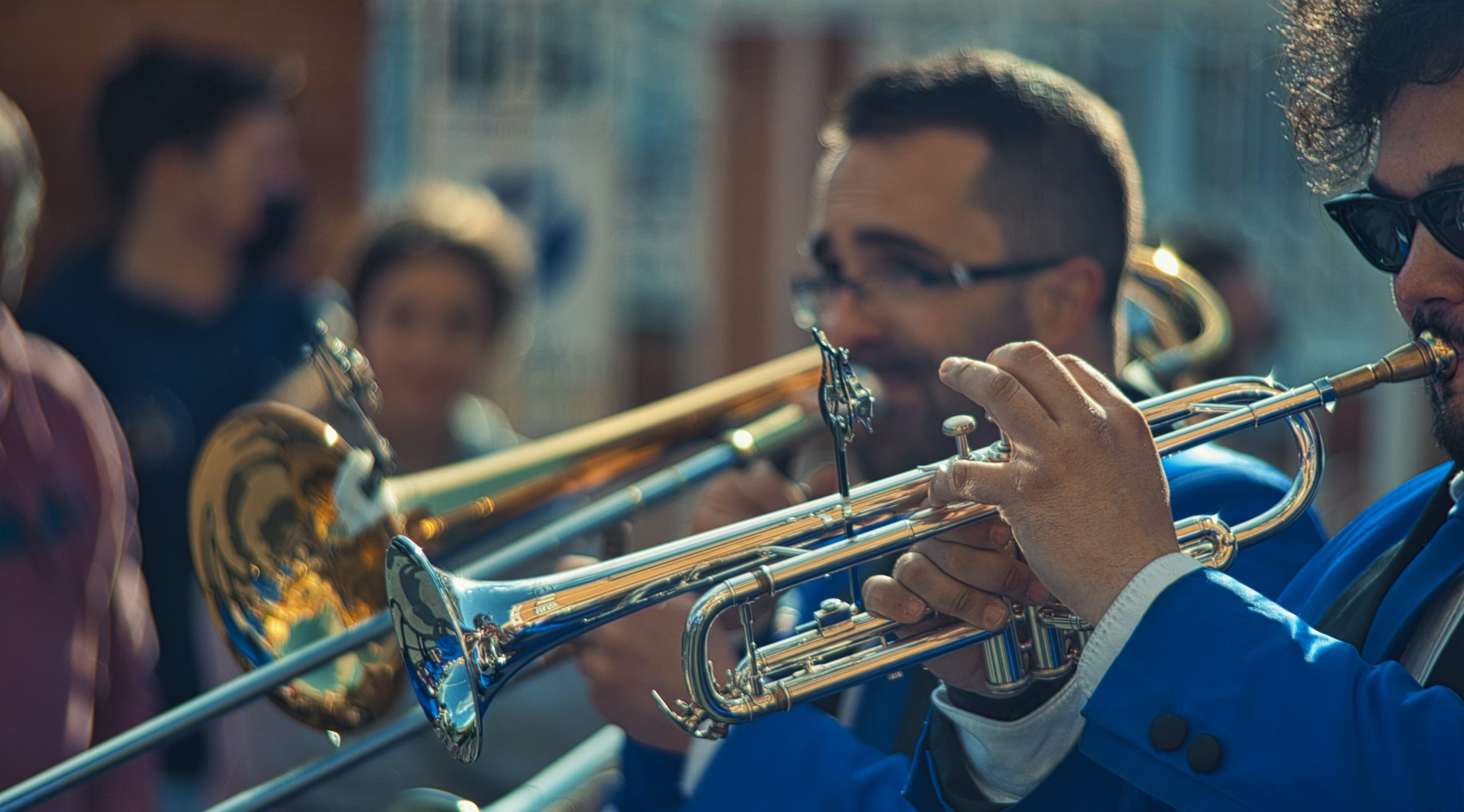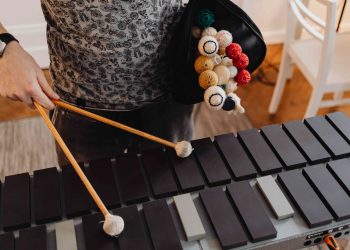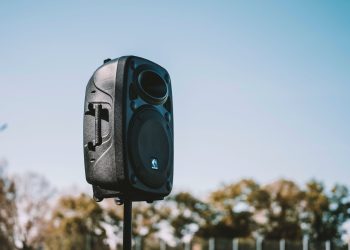The trombone is a versatile and expressive musical instrument that has been a staple of many musical genres for centuries. Whether you’re a seasoned player or just starting out, finding the right trombone can make a big difference in your playing experience. With so many options available, it can be difficult to know where to start. That’s why we’ve put together a list of the top 10 best trombones, based on factors such as sound quality, playability, and durability. From student models to professional-grade instruments, our list has something for everyone. Whether you’re looking for a trombone for jazz, classical, or marching band, we’ve got you covered. With this guide, you’ll be able to find the perfect trombone for your needs and budget. So, let’s dive in and discover the top 10 best trombones on the market today!
The Mendini by Cecilio Trombone Kit is a premium musical instrument for students, music instructors, and beginners. With a silver-plated mouthpiece and smooth action slides, this B Flat tenor slide trombone produces a full-bodied sound. The kit includes a pocketbook, hard carry case, gloves, and cleaning accessories, making it a complete solution for anyone looking to start playing trombone. Whether for a household or a marching band, this elegant instrument is sure to inspire.
2. pInstrument Plastic pBone Trombone
The pInstrument Plastic pBone Trombone is a fun and functional instrument for musicians of all levels. With a standard .500 bore pitched in Bb, this plastic trombone produces a rich, lower sound like its brass equivalent. Half the weight of a brass trombone, the pBone is easy to play and hold, making it ideal for students. The trombone requires no maintenance and comes with two mouthpieces and a fabric carrying case. Designed by award-winning musicians, it's virtually indestructible and eco-friendly. Order your pBone trombone in your school color and enjoy free access to fun backing tracks and online resources!
3. Eastar Bb Tenor Slide Trombone for Beginners Students
The Eastar Bb Tenor Slide Trombone is designed for beginners and students with its easy-to-use, patent-designed keys and shoulder pad for stability during playing. Made with high-quality brass and two layers of coating tubes, this trombone has a stable vibration and strong penetration for a clean, accurate tone. The elegant design features a laser-engraved logo and is a great gift choice. The package includes a trombone, gloves, cleaning kit, mouthpiece, hard case, and a 12-month warranty with customer support. Get ready to play with everything you need in one package!
4. Eastrock Trombone Bb Tenor Slide Gold
The Eastrock Trombone Bb Tenor Slide Gold is a high-quality musical instrument made of brass with a beautiful tone. Designed with a 12.5mm pipe and 200mm bell mouth, it has stable vibration and strong penetration, making it suitable for kids, students, and beginners. The trombone is protected with professional paint technology for a beautiful and clear appearance. It comes with a high-quality case for better protection and ease of transport. Eastrock offers a no-hassle warranty, providing free parts for as long as you own the instrument with proof of purchase. Reach out to their support team for any assistance.
5. Glory GTD-2 B Flat Brass Trombone with Case & 12C Mouthpiece
The Glory GTD-2 B Flat Brass Trombone is a high-quality musical instrument crafted from durable brass material. It features a B Flat key and a flat style design, making it suitable for a range of musical genres. The package includes a 12C mouthpiece and a sturdy carrying case, ensuring your instrument stays protected while on the go. With a 9/10 rating, this trombone is a great option for beginner to intermediate players looking for a reliable and stylish instrument. Whether you're performing in a concert band or just jamming with friends, the Glory GTD-2 is sure to impress.
6. Glory High Grade Bb/F Key Intermediate TENOR Trombone with Case
The Glory High Grade Bb/F Key Intermediate Tenor Trombone is an excellent choice for aspiring musicians. Made of high-quality brass, this trombone features an F key and a smooth-playing mouthpiece, making it ideal for intermediate players. The included case will protect the instrument when not in use and make it easy to transport. Whether you're practicing at home or performing on stage, this trombone is sure to deliver a powerful and rich sound that will impress your audience. With its impressive craftsmanship and versatility, the Glory High Grade Trombone is a great investment for any aspiring trombone player.
7. Eastrock Trombone Bb Tenor Slide Gold
The Eastrock Trombone Bb Tenor Slide Gold is a high-quality musical instrument designed for kids, students, and beginner musicians. Made from brass, this trombone produces a beautiful, penetrating sound with accurate tone. Its 12.5mm pipe and 235mm bell mouth provide stable vibration and strong penetration. The trombone is protected with professional paint technology, ensuring its beautiful appearance lasts a long time. The included high-quality case is designed to protect the trombone from squeezing and collision and can be carried on the shoulder for added convenience.
8. Ashthorpe Bb Tenor Slide Trombone with Nickel Plated Finish
The Ashthorpe Bb Tenor Slide Trombone is a high-quality musical instrument designed for beginner and student musicians. Made from durable brass, this trombone offers great handling and playing experience. With a Bb key, .500-inch bore, 8-inch bell, and nickel plated hand slide, this trombone produces a bright, penetrating sound with a clean voice and a smooth, accurate tone. The brass body is available in either gold lacquer or nickel plated finish, both of which offer a brilliant shine. This complete instrument package comes with a premium case, polishing cloth, white gloves, slide grease, and piston oil, ensuring proper maintenance and care for long-lasting enjoyment.
9. Brand New Bb/F Tenor Trombone w/Case and Mouthpiece
The Brand New Bb/F Tenor Trombone is a high-quality musical instrument designed for beginner and intermediate musicians. Made from durable brass, this trombone features a flawless gold lacquer finish and is available in the key of Bb/F. With a .54" bore size and 9.252" bell size, this trombone produces a rich and powerful sound. The included mouthpiece and case make it easy to transport and store the instrument, ensuring it stays protected when not in use. With a 8.6/10 rating, this trombone is a great investment for aspiring musicians looking for a reliable and stylish instrument. Whether you're performing in a concert band or just jamming with friends, the Brand New Bb/F Tenor Trombone is sure to impress.
10. summina Alto Trombone Brass Gold Lacquer
The summina Alto Trombone is a professional-grade musical instrument designed for students, beginners, teachers, and aspiring musicians. Made from high-grade brass, this trombone features a Bb tone and a cupronickel piston, producing a rich and powerful sound. The package includes a cupronickel mouthpiece, cleaning stick, a pair of gloves, and a hardshell case for easy storage and transportation. With a 6-month warranty, this alto trombone is a great investment for anyone looking for a reliable and high-quality instrument. Whether you're starting out or looking to upgrade your current trombone, the summina Alto Trombone is sure to impress.
Frequently Asked Questions
[faq-schema id=”127547″]
Trombone Selection Tips
The trombone is a versatile and expressive musical instrument that has been a staple of many musical genres for centuries. Whether you’re a seasoned player or just starting out, finding the right trombone can make a big difference in your playing experience. With so many options available, it can be difficult to know where to start. That’s why we’ve put together some tips to help you select the perfect trombone for your needs and budget.
Consider your skill level:
If you’re a beginner, you may want to start with a student model trombone that is designed for ease of use and affordability. As you progress and improve your playing, you may want to consider upgrading to a professional model trombone that offers better sound and playability.
Decide on a type of trombone:
There are several types of trombones to choose from, including straight tenor trombones, F attachment trombones, and bass trombone. A straight tenor trombone is a good choice for beginners and is commonly used in classical music. An F attachment trombone is more versatile and is often used in jazz, while a bass trombone is larger and is used in orchestral and big band music.
Consider the sound quality:
When selecting a trombone, it’s important to consider the sound quality. Try to listen to several different trombones to get a feel for the sound you’re looking for. A good trombone should have a rich, warm tone that is easy to control and produces a clear sound across all registers.
Look for a responsive instrument:
A responsive trombone is one that responds quickly and easily to changes in air flow and embouchure. This is important for achieving good sound quality and playing with expression.
Pay attention to intonation:
Intonation refers to the accuracy of the pitch produced by the trombone. A good trombone should produce accurate pitch across the entire range of the instrument. Try playing different notes to see if the pitch is consistent.
Consider the build quality:
A trombone should be well-constructed with high-quality materials. Look for a trombone with sturdy braces, smooth slides, and well-placed tuning slides. A good trombone should also be free of any dents or other signs of damage.
Set a budget:
Trombones can range in price from a few hundred dollars to several thousand dollars. It’s important to set a budget and stick to it when selecting a trombone. Keep in mind that a more expensive trombone may offer better sound and playability, but a good-quality student model trombone can still provide an enjoyable playing experience.
Try before you buy:
Whenever possible, try to play the trombone before making a purchase. This will give you a feel for the sound, playability, and responsiveness of the instrument. You may also want to consider renting a trombone for a few months before making a purchase to ensure that you’re happy with your choice.
Types of Trombones
The trombone is a musical instrument that has been a staple of many musical genres for centuries. With its distinctive sound and versatility, it’s no wonder that the trombone continues to be a popular choice for musicians of all skill levels. However, with so many types of trombones available, it can be difficult to know where to start. That’s why we’ve put together a comprehensive guide to the different types of trombones, so you can choose the one that’s right for you.
Straight Tenor Trombone:
The straight tenor trombone is the most basic type of trombone and is a good choice for beginners. It has a simple, cylindrical design with a single slide and is commonly used in classical music. The straight tenor trombone is also a popular choice for students, as it is relatively affordable and easy to play.
F Attachment Trombone:
The F attachment trombone is a more versatile type of trombone that is commonly used in jazz and popular music. It has an additional valve that allows the player to switch between different notes quickly and easily. This makes it a good choice for musicians who want a trombone that can produce a wide range of sounds and dynamics.
Bass Trombone:
The bass trombone is a larger type of trombone that is used in orchestral and big band music. It has a deeper, warmer sound and is typically played in the lower registers. Bass trombones are often used in combination with other trombones to create a rich, full sound.
Alto Trombone:
The alto trombone is a smaller type of trombone that is used in classical and orchestral music. It has a higher-pitched sound and is typically played in the key of E flat. The alto trombone is a less common type of trombone and is not often used in popular music.
Tenor-Bass Trombone:
The tenor-bass trombone is a hybrid type of trombone that combines the sound of a tenor trombone with the size of a bass trombone. It is often used in orchestral and big band music and is a good choice for musicians who want a trombone that is versatile and can produce a range of sounds.
Valve Trombone:
The valve trombone is a type of trombone that uses valves, similar to those found on a trumpet or other brass instrument, to change the pitch of the instrument. Valve trombones are less common than slide trombones and are not often used in orchestral or classical music.
When selecting a trombone, it’s important to consider your skill level, the type of music you will be playing, and your budget. A student model trombone may be a good choice for beginners, while a professional model trombone may provide a better sound and playing experience for advanced players. A straight tenor trombone is a good choice for classical music, while an F attachment trombone is more versatile and is often used in jazz and popular music. The bass trombone is larger and is used in orchestral and big band music, while the alto trombone is smaller and is used in classical music.
Trombone Brands
The trombone is a musical instrument that has been a staple of many musical genres for centuries, and there are many different brands available. When selecting a trombone, it’s important to consider the brand, as different brands offer different levels of quality and features. This article will provide a comprehensive guide to some of the best trombone brands, so you can choose the one that’s right for you.
Bach:
Bach is a well-known brand that has been producing high-quality trombones for over 100 years. Bach trombones are known for their rich, warm sound and excellent intonation, and they are a popular choice for both beginners and professional musicians. Bach trombones are available in a range of styles, including straight tenor trombones, F attachment trombone, and bass trombone.
Conn:
Conn is another well-known brand that has been producing trombones for over a century. Conn trombones are known for their excellent sound quality and playability, and they are a popular choice for musicians of all skill levels. Conn trombones are available in a range of styles, including straight tenor trombone, F attachment trombone, and bass trombone.
Yamaha:
Yamaha is a leading brand in the musical instrument industry, and their trombones are known for their excellent sound quality and playability. Yamaha trombones are available in a range of styles, including straight tenor trombone, F attachment trombone, and bass trombone. Yamaha trombones are a popular choice for musicians of all skill levels and are known for their affordability and reliability.
King:
King is a well-respected brand that has been producing trombones for over a century. King trombones are known for their excellent sound quality and playability, and they are a popular choice for musicians of all skill levels. King trombones are available in a range of styles, including straight tenor trombone, F attachment trombone, and bass trombone.
Holton:
Holton is a well-known brand that has been producing trombones for over a century. Holton trombones are known for their excellent sound quality and playability, and they are a popular choice for musicians of all skill levels. Holton trombones are available in a range of styles, including straight tenor trombone, F attachment trombone, and bass trombone.
Getzen:
Getzen is a well-respected brand that has been producing trombones for over 70 years. Getzen trombones are known for their excellent sound quality and playability, and they are a popular choice for musicians of all skill levels. Getzen trombones are available in a range of styles, including straight tenor trombone, F attachment trombone, and bass trombone.
When selecting a trombone, it’s important to consider the brand, as different brands offer different levels of quality and features. Bach, Conn, Yamaha, King, Holton, and Getzen are all well-respected brands that have been producing high-quality trombones for many years. Consider your skill level, the type of music you will be playing, and your budget when selecting a trombone brand. It’s also a good idea to try out different trombones to find the one that feels and sounds best to you.
Parts of a Trombone
The trombone is a musical instrument that has been a staple of many musical genres for centuries. Understanding the different parts of a trombone is important for playing the instrument effectively and maintaining it properly. In this article, we’ll take a closer look at the various parts of a trombone and their functions.
Bell:
The bell is the large, flared end of the trombone that projects the sound. The size and shape of the bell can have a big impact on the sound of the trombone, and different bells are used for different types of music. Bells can be made of brass, bronze, or other materials, and are typically hand-spun for optimal sound quality.
Slide:
The slide is the long, cylindrical part of the trombone that allows the player to change the pitch of the instrument. The slide is moved in and out to change the length of the instrument, which in turn changes the pitch. The smoothness and responsiveness of the slide is important for playing the trombone effectively.
Inner Slides:
The inner slides are the smaller tubes inside the main slide that move when the slide is moved. The inner slides are critical for ensuring that the pitch of the trombone is accurate and consistent.
Mouthpiece:
The mouthpiece is the small, detachable part of the trombone that the player blows into to produce sound. The mouthpiece is made of brass or other materials and can have a big impact on the sound of the trombone. The mouthpiece should fit comfortably in the player’s mouth and allow for good air flow.
Leadpipe:
The leadpipe is the small, cylindrical part of the trombone that connects the mouthpiece to the rest of the instrument. The leadpipe helps to direct the air flow and shape the sound of the trombone.
Tuning Slide:
The tuning slide is the part of the trombone that is used to adjust the tuning of the instrument. The tuning slide is located near the bell and is moved in and out to change the pitch of the trombone. The smoothness and responsiveness of the tuning slide is important for playing the trombone effectively.
Valve:
An F attachment trombone has an additional valve that is used to change the pitch of the instrument. The valve is located near the leadpipe and is used to switch between different notes quickly and easily.
How to Clean a Trombone
Keeping your trombone clean is important for maintaining its sound quality and prolonging its lifespan. Regular cleaning and maintenance can also help to prevent the buildup of dirt, grime, and other debris that can affect the playability of the instrument. In this article, we’ll provide a step-by-step guide on how to clean your trombone.
Step 1: Gather Supplies
Before you start cleaning your trombone, make sure you have all the supplies you need. You will need a soft cloth, a cleaning rod, valve oil or slide grease, and a cleaning solution. Avoid using harsh chemicals, such as alcohol or vinegar, as these can damage the finish of your trombone.
Step 2: Disassemble the Trombone
Before cleaning the trombone, it’s important to disassemble it into its individual parts. This will make it easier to clean each part thoroughly. Start by removing the mouthpiece and the tuning slide. If your trombone has an F attachment, make sure to remove the valve as well.
Step 3: Clean the Bell
The bell is the largest part of the trombone and is often the dirtiest. Start by using a soft cloth to gently wipe away any dirt or grime. Then, use a cleaning solution to clean the inside and outside of the bell, making sure to get into all the crevices and grooves. Rinse the bell thoroughly with water and dry it with a soft cloth.
Step 4: Clean the Slide
The slide is one of the most important parts of the trombone, and it’s important to keep it clean and well-lubricated. Start by using a cleaning rod to push the inner slides out of the main slide. Then, use a soft cloth to clean the inside and outside of the slide, making sure to get into all the crevices and grooves. Apply a small amount of valve oil or slide grease to the inside of the slide to keep it lubricated.
Step 5: Clean the Mouthpiece
The mouthpiece is the part of the trombone that the player blows into to produce sound. Start by using a soft cloth to clean the outside of the mouthpiece, making sure to remove any dirt or grime. Then, use a cleaning solution to clean the inside of the mouthpiece, making sure to get into all the crevices and grooves. Rinse the mouthpiece thoroughly with water and dry it with a soft cloth.
Step 6: Clean the Valve
If your trombone has an F attachment, it will have a valve that is used to change the pitch of the instrument. Start by using a soft cloth to clean the outside of the valve, making sure to remove any dirt or grime. Then, use a cleaning solution to clean the inside of the valve, making sure to get into all the crevices and grooves. Apply a small amount of valve oil to the valve to keep it lubricated.
Step 7: Reassemble the Trombone
Once you have cleaned all the individual parts of the trombone, it’s time to reassemble it. Start by putting the mouthpiece and tuning slide back in place. Then, if your trombone has an F attachment, reattach the valve.
How to Learn to Play the Trombone (Step by Step)
The trombone is a versatile and expressive musical instrument that offers a wide range of sounds and dynamics. Learning to play the trombone can be a challenging and rewarding experience, and there are many different steps involved in the process. In this article, we’ll provide a step-by-step guide on how to learn to play the trombone.
Step 1: Choose a Trombone
The first step in learning to play the trombone is to choose an instrument. There are many different types of trombones available, and it’s important to choose one that is appropriate for your skill level and the type of music you want to play. Consider factors such as the size of the trombone, the material it’s made of, and the style of the bell when selecting a trombone.
Step 2: Find a Teacher
The next step in learning to play the trombone is to find a teacher. A good teacher can provide you with guidance and support as you learn to play the instrument, and can help you to overcome any challenges you may face. Look for a teacher who has experience teaching trombone and who is familiar with the type of music you want to play.
Step 3: Learn the Basics
Once you have chosen a trombone and found a teacher, it’s time to start learning the basics. This includes learning how to hold the trombone, how to make a sound, and how to produce different notes. Your teacher will likely start you with simple exercises and scales to help you build your technique and confidence.
Step 4: Practice Regularly
Practice is essential if you want to become a good trombonist. Set aside time each day to practice, and make sure to practice consistently over time. Start with short practice sessions and gradually increase the length of your practice sessions as you get more comfortable with the instrument.
Step 5: Learn Music Theory
Music theory is an important part of learning to play any musical instrument, and the trombone is no exception. Learning music theory will help you to understand how music works, and will give you the skills you need to read sheet music and play different types of music.
Step 6: Play with Others
Playing with others is an important part of the learning process, and can help you to develop your skills and refine your technique. Consider joining a band or orchestra, or finding other musicians to play with. This will give you the opportunity to play with others and learn from their experiences.
Step 7: Keep Learning
Learning to play the trombone is a lifelong process, and there is always more to learn. Keep working with your teacher, and continue to practice regularly. Attend concerts and recitals, and listen to recordings of professional trombonists to inspire and motivate you.
History of the Trombone
The trombone is a musical instrument that has a rich and fascinating history that spans many centuries. From its earliest origins in medieval Europe to its place in modern-day orchestras and jazz bands, the trombone has played a significant role in the development of Western music. In this article, we’ll take a closer look at the history of the trombone.
The origins of the trombone can be traced back to medieval Europe, where it was used in religious music and military brass ensembles. The trombone was originally known as the “sackbut,” and was played in a similar manner to the modern-day trombone, with the player using a slide to change the pitch of the instrument.
During the Renaissance period, the trombone became a popular instrument in orchestral music, and was used in a variety of musical genres, including classical, opera, and religious music. The trombone was often used to play the bass line in orchestral music, and was prized for its rich, powerful sound.
In the 19th century, the trombone became a staple of military brass bands, and was used in patriotic and marching music. The trombone was also used in classical music, and was featured in many famous works by composers such as Beethoven, Brahms, and Tchaikovsky.
The 20th century saw the trombone become an important part of jazz music, and the instrument was used by many famous jazz trombonists, such as J.J. Johnson, Tommy Dorsey, and Jack Teagarden. The trombone was also used in big band music, and was featured in many famous recordings by artists such as Duke Ellington and Count Basie.
Today, the trombone is still a popular instrument in a wide range of musical genres, and is used in classical orchestras, jazz bands, marching bands, and more. The trombone has also been featured in many popular films and television shows, and continues to be a beloved instrument for musicians and music lovers around the world.
Since 2005, Singersroom has been the voice of R&B around the world. Connect with us via social media below.
